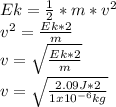
Physics, 30.10.2019 03:31 shonnybenskin8
Two identical +5.5 μc point charges are initially spaced 6.5 cm from each other. part a if they are released at the same instant from rest, how fast will they be moving when they are very far away from each other? assume they have identical masses of 1.0 mg .

Answers: 2
Another question on Physics

Physics, 21.06.2019 19:50
How can one distinguish breccia from conglomerate? a. breccia contains angular clasts and conglomerate contains rounded clasts. b. breccia contains rounded clasts and conglomerate contains angular clasts. c. different minerals cement breccia than cement conglomerate. d. breccia contains sand and conglomerate contains silt.
Answers: 1

Physics, 21.06.2019 20:30
If forces acting on an object are unbalanced, which factors may result fron an unbalanced force? check all that apply
Answers: 1

Physics, 21.06.2019 23:00
Follow these directions and answer the questions. 1. set up the ripple tank as in previous investigations. 2. bend the rubber tube to form a "concave mirror" and place in the ripple tank. the water level must be below the top of the hose. 3. generate a few straight pulses with the dowel and observe the reflected waves. do the waves focus (come together) upon reflection? can you locate the place where the waves meet? 4. touch the water surface where the waves converged. what happens to the reflected wave? 5. move your finger twice that distance from the hose (2f = c of c, center of the curvature) and touch the water again. does the image (the reflected wave) appear in the same location (c of c)? you may have to experiment before you find the exact location. sometimes it is hard to visualize with the ripple tank because the waves move so quickly. likewise, it is impossible to "see" light waves because they have such small wavelengths and move at the speed of light. however, both are examples of transverse waves and behave in the same way when a parallel wave fronts hit a curved surface.
Answers: 1

Physics, 22.06.2019 01:00
First, launch the video below. you will be asked to use your knowledge of physics to predict the outcome of an experiment. then, close the video window and answer the question at right. you can watch the video again at any point. part a as in the video, we apply a charge +q to the half-shell that carries the electroscope. this time, we also apply a charge –q to the other half-shell. when we bring the two halves together, we observe that the electroscope discharges, just as in the video. what does the electroscope needle do when you separate the two half-shells again? view available hint(s) as in the video, we apply a charge + to the half-shell that carries the electroscope. this time, we also apply a charge – to the other half-shell. when we bring the two halves together, we observe that the electroscope discharges, just as in the video. what does the electroscope needle do when you separate the two half-shells again? it deflects more than it did at the end of the video. it deflects the same amount as at end of the video. it does not deflect at all. it deflects less than it did at the end of the video. submit
Answers: 2
You know the right answer?
Two identical +5.5 μc point charges are initially spaced 6.5 cm from each other. part a if they are...
Questions




Mathematics, 29.10.2020 23:30

History, 29.10.2020 23:30

Physics, 29.10.2020 23:30




History, 29.10.2020 23:30

Mathematics, 29.10.2020 23:30

Mathematics, 29.10.2020 23:30


Social Studies, 29.10.2020 23:30


English, 29.10.2020 23:30

Chemistry, 29.10.2020 23:30



Mathematics, 29.10.2020 23:30









